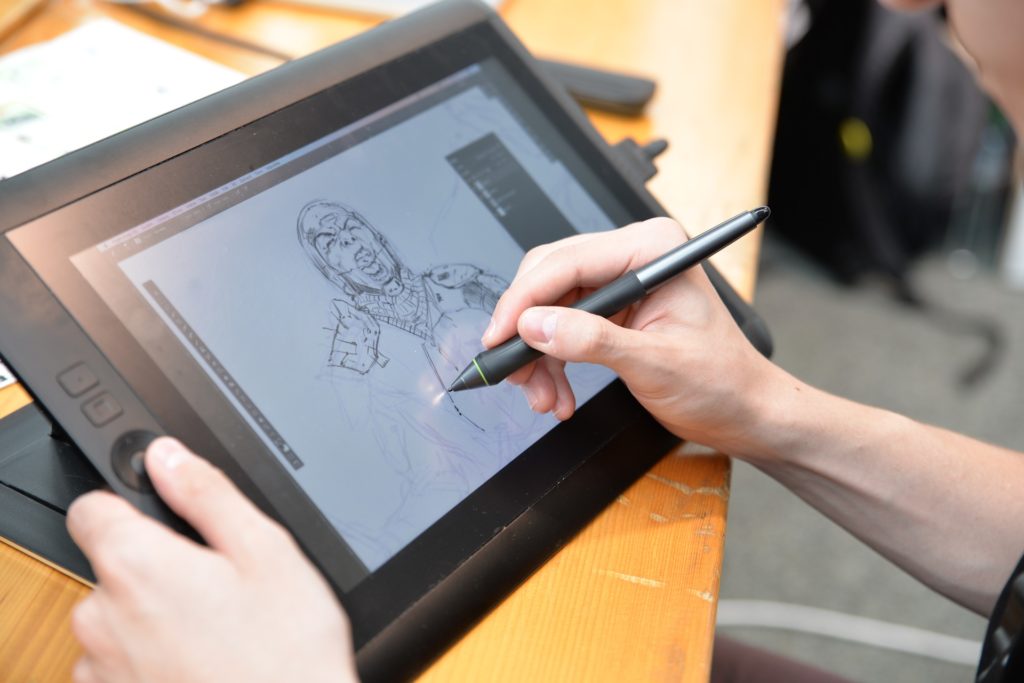We’ve looked at how to create an academic portfolio – but how about building yourself an impressive creative portfolio?
WHAT IS A CREATIVE PORTFOLIO?
Your creative portfolio is an organised collection of creative work showcasing your creativity, your practical abilities and/or your design-thinking skills. Depending on the job or creative field (animation, film, visual effects, graphic design, screenwriting, etc), the creative portfolio may be presented in different formats:
- A printed portfolio
- An online portfolio
- A ‘pitch-bible’
- A showreel
etc.
A creative portfolio should not just be a collection of your best creative work. Rather, you should think of your portfolio as a visually coordinated, fully cohesive ‘creative work’ in its own right – a creative job ‘packaged like a product and clearly thought out’ (Cleaver).
STEP ONE – GET STARTED
Target your audience.
To work in communications, you’ll need to be able to communicate to your target audience – in this case, your potential employer. How will your creative skills specifically help them?
Do your research – cater your portfolio to appeal to the studio, job or position you’re applying for.
Select strong material – ‘if in doubt, leave it out’.
Speaking from a design context, Phil Cleaver of ‘What They Didn’t Teach You At Design School recommends including your 5 strongest pieces of work.
Similarly, showreels should not exceed 1-2 minutes.
“It’s not about the amount of content you have, but the quality of the content and the potential of your ideas,” advises design student Maria Yanovsky, 26, currently studying a Bachelor of Design in Visual Communication, “curate your portfolio to include varied, thoughtful work.”
But keep it simple.
“Studios and professionals may also not have a lot of time to look at your work,” says Yanovsky, “keeping your portfolio clean not only looks more professional but is regarded a considerate move.”
STEP TWO – CONSIDER PRESENTATION
Package work professionally.
Depending on your creative field, the format of your work will vary.
Try demonstrating your individual personality, showmanship and creative problem-solving skills by presenting your work in a way that ‘speaks to designers in their own visual language'(Cleaver). Designing for magazines? Transform your work into a glossy new edition! Pursuing packaging design? Prepare physical prototypes!
Don’t always use the ‘black art-school folio’ approach – package accordingly for the job, studio or position.
Start – and end – on a high.
Place your strongest piece of work first and second-best last (or vice-versa). When putting together a showreel or portfolio, Bachelor of Design in Animation student Ryley Miller, 22, recommends both starting and ending on a high note.
“Start awesome. The first thing on your portfolio or showreel should be your proudest achievement, or at least the most dazzling, impressive thing you’ve created. You want to hook anyone who finds your reel from the first few seconds.
“Secondly, end with a bang. Your second favourite scene or shot should be your reel’s conclusion – it leaves a satisfying impression,” Miller said.
Be detail orientated.
Clearly define your key input.
Were you working on projects as an individual or in a team? Avoid grey areas – clearly annotating your personal contributions indicates you’re a team-player and won’t unprofessionally claim the work of others as your own. Consider displaying agency, internship or group work separate to your personal design-school work.
Include your details!
Where are you based? How can you be contacted (email, social media, phone number, etc)? What position are you applying for? Try to be as specific as possible so potential employers won’t need to chase you up.
EXTRA CONSIDERATIONS
If possible, present online.
Whilst having a professionally designed personal website is preferable, if presented professionally enough, portfolio websites such as Behance, Carbonmade, The Loop, The Style File and Vimeo can make great alternative platforms for showcasing creative work online.
However, also showcase your physical skills.
Printing physical copies of your portfolio can demonstrate craftsmanship and stimulate conversation during job interviews. If you can, show your actual work!
Your creative portfolio should develop with you.
Evaluate and update your portfolio at the end of every year (or even six months).
STEP 3 – NETWORK EFFICIENTLY
After studying a combined degree of Bachelor of Design in Visual Communication and International Studies in Japanese, graphic designer Xue Situ, 24, now works in the creative industry, specialising in illustration, motion graphics and visual design. Situ still recalls her early student days applying for internships and studio jobs, during which a well-built creative portfolio proved an essential tool.
“For my first couple of jobs,” says Situ, “my portfolio was crucial. However, nowadays my new jobs are from word-of-mouth, and the portfolio plays a smaller part.”
Whilst a great creative portfolio may get your foot in the door, networking is another vital part of breaking into the creative industry.
- Cultivate an online presence – use social media to network with other creatives working in your creative field.
- Make local friends – word of mouth travels fast! The more you engage in your local community, the more you’ll hear about and be recommended for new opportunities.
- Attend local (and underground) creative industry events – showing up to events demonstrates to peers that you’re passionate, enthusiastic and dedicated to your craft – and allows you to network with passionate others working in your desired creative field.
For aspiring creatives, Situ offered some parting advice.
“Network in your jobs and make sure to keep a good attitude,” she said, “you never know where it may lead you.’
The Academy of Information Technology (AIT) offers a range of course options that will get you right into the creative field. You’ll enjoy the benefits of small campuses and classes with low student-to-teacher ratios; hands-on, practical learning in state-of-the-art facilities such as a green screen room, audio recording room, PC and Mac labs; the opportunity to attend and gain insights at industry events; and a final-year subject known as The Forge, where students are able to work in groups on project briefs taken from industry, using real-life methods and processes that are critiqued by industry professionals. For more information, head to the AIT website.






